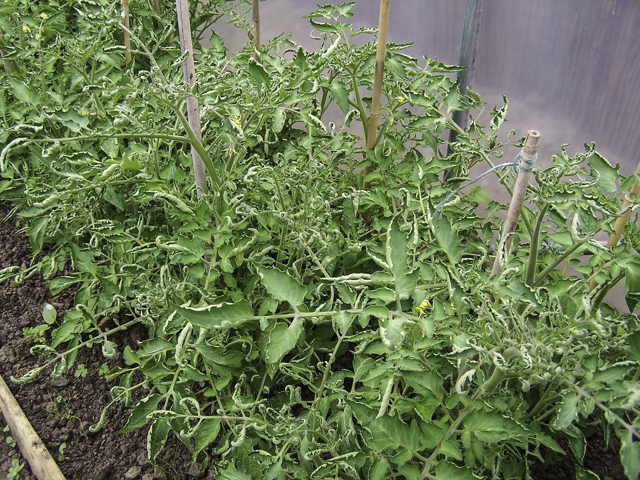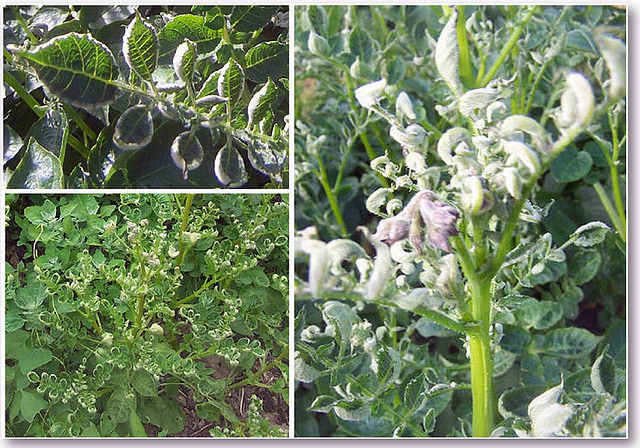

Home
About Us
Seed Suppliers
Manure Problems
Children's Pages
GLA Blog
Weather Blog
School Veg Patch
Useful Links
Aminopyralid Contamination of Manure
Aminopyralid is relicenced and is an active ingredient in Forefront, to name just one pesticide, Clopyralid is an active ingredient in Verdone Extra - a lawn weedkiller available to amateur gardeners and other pesticides. Clopyralid has a similar effect to aminopyralid. Instructions for use state “The first mowing after application must not be used as a mulch, either fresh or after composting since it may damage desired plants. Dispose of via normal household waste. Do not dispose of via council composting schemes. The next three mowings should be used as a mulch only after composting well for at least 9 months.”
We all must rely on users sticking to these instructions.
In June 2008 a group of plot holders on our site noticed that potato and tomato crops were not growing well. Both types of crop were displaying distorted leaf formation. We realised that the problem was confined to areas where plot holders had applied manure which had been purchased from the same supplier which indicated that the manure was the source of our problems. This instigated more investigation and we discovered that the problem, which was identified as likely to be hormonal herbicide contamination, was not just affecting our allotment site. It also seemed that the contamination was not confined to manure as some reported that bagged compost seemed to be affected. 
I decided to post information on my website so that others having problems had access to all the information that we had managed to gather. The suspect herbicide aminopyralid had its licence withdrawn by the manufacturer and after they drafted a improved stewardship the Chemicals Regulations Directorate (CRD) - formerly Pesticide Safety Directorate re-approved the licence. This means that the chemical is back in use so we need to be vigilant in monitoring whether the new stewardship is affective. An information sheet offering advice to anyone obtaining manure can be accessed here.
Cupping of leaves upwards is a typical sign of hormonal herbicide contamination. New growth may take on a fern-like appearance. Leaf texture may become leathery and veins may appear more prominent. In some plants the veins will be parallel to one another.
 The pages linked from here tell the story in full and hopefully the photographs and video helped in identification of the problem.
The pages linked from here tell the story in full and hopefully the photographs and video helped in identification of the problem.
June 2008 - Identifying the problem
Fact Finding - More Information
Map showing spread of problem as reported to this website
Reports from 2008 & 2009 victims one year on
Reports of suspected problems in 2010
Pesticide Safety Directorate actions, information and comments
Advice based on victims' experiences
Press release from DOW 16 June 2010
2011 - No time to let down your guard
It’s not just aminopyralid
You should also be aware that clopyralid, which is an active ingredient in some domestic lawn weedkillers, can also have the same effect as aminopyralid. After treating lawns with weedkiller grass clippings should not be composted or used as a mulch. Check the instructions supplied with the product for more information. Resulting grass clippings should not be disposed of in council green waste bins. It is possible that if affected grass clippings are disposed of in green waste bins that contaminated material may find its way into the supply chain for products, such as composts, that use green waste as an ingredient. Just for reference the potato council has photos of symptoms of the many pests and diseases that can affect potatoes click here
Press release from DOW AgroSciences 17 June 2010
Reintroduction of aminopyralid products will not lead to more manure problems
Aminopyralid herbicides have been re-introduced this year to help grassland farmers deal with difficult to control weeds but with tight controls to prevent problems with manure management.
Aminopyralid herbicides are the most effective solutions to control dock, thistle, nettle, and buttercup infestations in grassland. To ensure that their use does not lead to a repeat of the issues seen previously, their availability is now tightly controlled with a significantly amended label and a stewardship scheme which ensures farmers are aware of the implications for subsequent manure management. The herbicides cannot be used on grassland destined for hay and silage nor on grassland grazed by horses. This year sales are restricted to Scotland, South West England and Northern Ireland.
There have been some incidents this year of manure containing aminopyralid ending up on gardens and allotments.
“This is disappointing and upsetting for those affected,” said Dow AgroSciences principal biologist Andy Bailey. “Although of small comfort, we would reassure anyone affected that this manure has not come from use this season under the new controls. It is a reflection of manure generated from past treatment and kept in heaps for more than a year. Also, the past long winter means old stocks of forage will have been consumed on livestock farms.”
The new restriction in aminopyralid use will mean any manure returns immediately to pasture where it will cause no harm and cannot leave the farm. The stringent use restrictions are explained in detail to every professional farmer who wants to buy a product and a written confirmation of understanding must be completed.
Dow AgroSciences’ advice to concerned farmers or gardeners remains the same – to check carefully the provenance of any manure being used where sensitive crops, such as potatoes, peas, beans and carrots, may be grown.
“If anyone supplying manure cannot state with certainty that no aminopyralid-based product (sold as Forefront, Pharaoh or Banish) was used on the forage from which the manure resulted, then it is best not to accept any supply,” says Mr Bailey. “For anyone who has manure and is concerned, please contact us through our dedicated website http://www.manurematters.co.uk.This site also contains detailed information and frequently asked questions for gardeners, horse owners and professional grassland farmers.”
Press release ends
Additional information:
I couldn't find any information on the new labelling for the UK but found this information with respect to Canada click here
Herbicide packaged before the reintroduction have been recalled see here
Question:
Anyone know why sales are being restricted to Scotland, South West England and Northern Ireland? (Not why sales are being restricted just why have they chosen these areas?
July 2012Sales still restricted to Scotland, Northern Ireland and the South-West of England (Devon, Cornwall, Wiltshire, Somerset and Dorset)
Adding your experiences
If you have had recent experience of what you suspect to be herbicide contamination that you wish to share please contact me with information e.g. where you garden, how many gardeners are affected, what you suspect is the source, decription of affects and any photographs
Our Plot at Green Lane Allotments Blog | A Gardener's Weather Diary | School Vegetable Patch Website
© Our Plot on Green Lane Allotments - Please email me if you wish to use any of this site's content